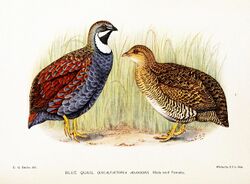Biology:Blue quail
| Blue quail | |
|---|---|

| |
| Scientific classification | |
| Domain: | Eukaryota |
| Kingdom: | Animalia |
| Phylum: | Chordata |
| Class: | Aves |
| Order: | Galliformes |
| Family: | Phasianidae |
| Genus: | Excalfactoria |
| Species: | E. adansonii
|
| Binomial name | |
| Excalfactoria adansonii (Verreaux & Verreaux, 1851)
| |
| Synonyms | |
| |
The blue quail or African blue quail[1] (Excalfactoria adansonii) is a species of bird in the family Phasianidae. It is found in Sub-Saharan Africa.
Taxonomy
The blue quail was described as Coturnix adansonii by Jules Verreaux and Édouard Verreaux in 1851.[2] It is named after the French naturalist Michel Adanson.[3] The IOC World Bird List places it in the genus Excalfactoria,[4] while the Handbook of the Birds of the World places it in Synoicus. Sometimes considered a subspecies of the king quail, the species is monotypic.[5]
Distribution and habitat
The species is found in Sub-Saharan Africa.[1] It ranges from Sierra Leone to Ethiopia, and south to Zambia, and eastward to Kenya.[6] The habitat of the blue quail excludes dry areas. Inhabiting mainly grassland and fields, the birds typically live near rivers or other bodies of water.[6]
Description
The blue quail is 14–16.5 cm (5.5–6.5 in) long and weighs 43–44 g (1.5–1.6 oz).[6] Its legs are yellow. The colour of the eyes varies from brown in the juvenile to red in the breeding male.[1] The species is sexually dimorphic.[1] The male's plumage is mostly dark slaty-blue, with rufous patches on its wings.[7] The male has a black beak,[1] a brown head,[6] and a black and white throat.[7] There is a white patch on its breast. Its flight feathers are brown. The forehead, sides of the head and neck, and flanks of the female are orange-buff. Its crown is brown, with black mottles.[1] The female's beak is brownish. Its underparts are buff, with black bars, and its upperparts have black and rufous mottles and streaks. The juvenile is similar to the female.[1]
Behaviour
The blue quail is migratory. It often migrates to regions at the start of the rainy season and leaves early in the dry season.[1] It eats seeds, leaves, insects and molluscs.[6] Its voice is a piping whistle, kew kew yew.[7] It also gives the whistle tir-tir-tir when it is flushed.[1] The blue quail is monogamous. The nest is a scrape. Eggs are usually laid at the beginning of the rainy season.[1] There are 3 to 9 olive-brown eggs in a clutch. The eggs have reddish and purplish freckles. They are incubated by the female for around 16 days.[1] The chicks are precocial.[6]
Status
The blue quail has a large range and appears to have a stable population trend. The IUCN Red List of Threatened Species has listed the species as least concern.[8]
References
- ↑ Jump up to: 1.00 1.01 1.02 1.03 1.04 1.05 1.06 1.07 1.08 1.09 1.10 McGowan, Phil; Madge, Steve (2010). Pheasants, Partridges & Grouse: Including buttonquails, sandgrouse and allies. Bloomsbury. p. 244. ISBN 9781408135655. https://books.google.com/books?id=WffUBAAAQBAJ&pg=PA244.
- ↑ Verreaux, Jules; Verreaux, Ed. (1851). "Description d'espèces nouvelles d'oiseaux du Gabon (côte occidentale d'Afrique)" (in French). Revue et magasin de zoologie pure et appliquée. 2 3 (11): 513–516. https://www.biodiversitylibrary.org/page/2321484.
- ↑ Jobling, James A. (2010). Helm Dictionary of Scientific Bird Names. Bloomsbury. p. 31. ISBN 9781408133262. https://books.google.com/books?id=-RfSBAAAQBAJ&pg=PA31.
- ↑ Gill, F.; Donsker, D., eds. "Pheasants, partridges & francolins". http://www.worldbirdnames.org/bow/pheasants/. Retrieved 5 April 2018.
- ↑ McGowan, P. J. K.; Kirwan, G. M.. "African Blue Quail (Synoicus adansonii)". in del Hoyo, J.; Elliott, A.; Sargatal, J. et al.. Handbook of the Birds of the World Alive. Lynx Edicions. https://www.hbw.com/species/african-blue-quail-synoicus-adansonii.
- ↑ Jump up to: 6.0 6.1 6.2 6.3 6.4 6.5 Pappas, J.. "Coturnix adansonii". http://animaldiversity.ummz.umich.edu/site/accounts/information/Coturnix_adansonii.html. Retrieved 30 October 2016.
- ↑ Jump up to: 7.0 7.1 7.2 Redman, Nigel; Stevenson, Terry; Fanshawe, John (2010). Birds of the Horn of Africa: Ethiopia, Eritrea, Djibouti, Somalia and Socotra. Bloomsbury. p. 130. ISBN 9781408135761. https://books.google.com/books?id=NPfUBAAAQBAJ&pg=PA130.
- ↑ Cite error: Invalid
<ref>tag; no text was provided for refs namedIUCN
External links
- Blue quail - Species text in The Atlas of Southern African Birds
Wikidata ☰ Q1123824 entry


